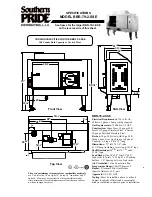
Installation
Wire we hear? (This section is important)
Before you start…
Take a moment to read these recommendations.
1. Always shut off the power to all components before installing!
2. Use quality speaker wire. We recommend two-conductor wire with high quality copper.
You’ll also want to make sure that there is a means of determining polarity (identifying the
positive and negative strands).
3. All wire has resistance in it. The thicker the wire, the less resistance it has. The less resis-
tance, the better your speakers will sound. The thickness of the wire should be deter-
mined by the length of the wire you are using. For longer lengths, heavier wire should be
used. See our table below:
Length of speaker wire (each speaker)
Recommended minimum thickness
Up to 15 feet
16 AWG
15 to 30 feet
14 AWG
Over 30 feet
12 AWG
4. When connecting wire to a terminal, twist the wire strands together so that they all can be
neatly inserted into the terminal.
If strands are left loose and make contact with the terminal
or a wire of the opposite polarity, they will cause a short and can severely damage your
speakers and equipment.
Phasing
It’s critically important that the speakers all work together. To accomplish this, all speakers
must be wired in phase.
This means, that for each speaker and for your receiver, every positive wire is correctly con-
nected to a positive (+) terminal and every negative wire is properly connected to a negative (-
) terminal. When this is the case, all of your speakers are considered to be “in phase”. On our
speakers, the positive (+) input terminal is identified with the color red, while the negative (-)
input terminal is labeled with black. Your receiver or amplifier will provide identification by
plus (+) and minus (-) symbols or by colors also (commonly red for positive and black for nega-
tive).
If you are human like some of us, and you inadvertently connect some wires backwards, you
will hear the results. Having a speaker out of phase significantly degrades sound quality. In a
stereo system, out of phase speakers will sound as if there is a hole in the imaging between
the speakers. Voices can sound as if they are far away from you; coming from behind your
speakers. Incorrect phasing can also significantly diminish bass response. Therefore, it is im-
portant to make sure that the polarity of every connection is consistent.
15











































